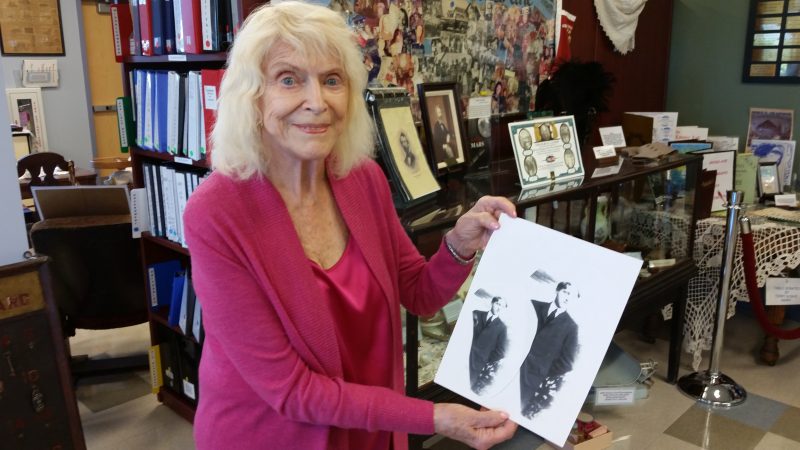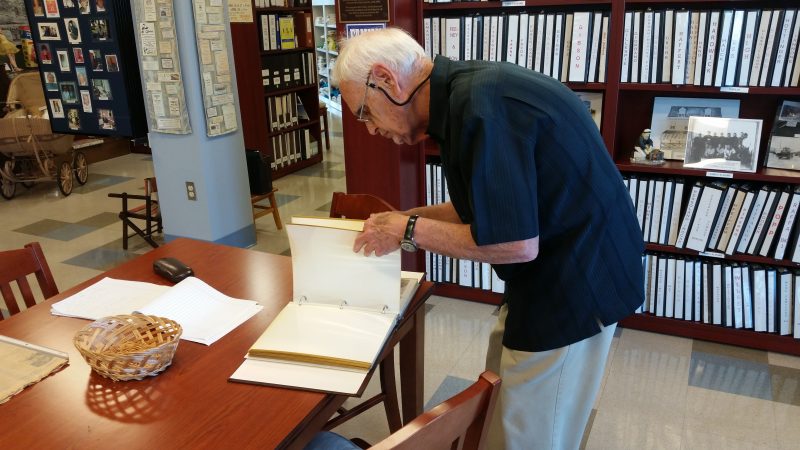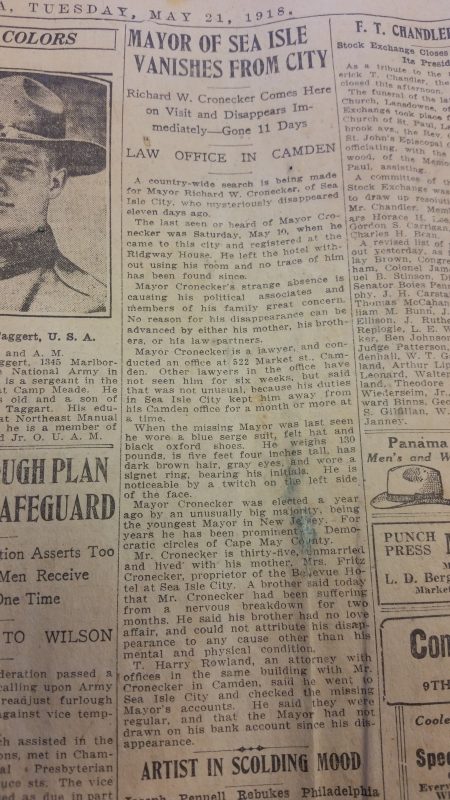Museum volunteer Shirley Gill points to a 1918 newspaper article that contains the shocking headline that Sea Isle's mayor "vanishes."
 By Donald Wittkowski
The headline in the May 21, 1918, edition of The Evening Bulletin of Philadelphia contained a stunning revelation: “Mayor Of Sea Isle Vanishes From City.”
It seemed unbelievable at the time, but it was true. Mayor Richard W. Cronecker, a member of a prominent Sea Isle hotel and restaurant family, had inexplicably disappeared without a trace.
“A country-wide search is being made for Mayor Richard W. Cronecker, of Sea Isle City, who mysteriously disappeared eleven days ago,” The Evening Bulletin story said in the first paragraph.
The story went on to say that Cronecker was last seen on May 10, 1918, when he visited Philadelphia and registered at the Ridgway House hotel.
“He left the hotel without using his room and no trace of him has been found since,” the article added.
Although every mystery deserves a great ending, this one, unfortunately, was never solved. Cronecker was never found, although there were at least two alleged sightings of him later in 1918.
Unsubstantiated and even wild rumors swirled at the time about the mayor’s whereabouts, according to an account of his disappearance written by the Sea Isle City Historical Museum.
There was speculation that he had traveled to Canada to join with British forces fighting in World War I. About a month after he vanished, he supposedly was seen boarding a Buffalo-bound train on his way to Canada.
Other dark rumors abounded that he had become a German spy because he was upset that Germany was losing the war.
By Donald Wittkowski
The headline in the May 21, 1918, edition of The Evening Bulletin of Philadelphia contained a stunning revelation: “Mayor Of Sea Isle Vanishes From City.”
It seemed unbelievable at the time, but it was true. Mayor Richard W. Cronecker, a member of a prominent Sea Isle hotel and restaurant family, had inexplicably disappeared without a trace.
“A country-wide search is being made for Mayor Richard W. Cronecker, of Sea Isle City, who mysteriously disappeared eleven days ago,” The Evening Bulletin story said in the first paragraph.
The story went on to say that Cronecker was last seen on May 10, 1918, when he visited Philadelphia and registered at the Ridgway House hotel.
“He left the hotel without using his room and no trace of him has been found since,” the article added.
Although every mystery deserves a great ending, this one, unfortunately, was never solved. Cronecker was never found, although there were at least two alleged sightings of him later in 1918.
Unsubstantiated and even wild rumors swirled at the time about the mayor’s whereabouts, according to an account of his disappearance written by the Sea Isle City Historical Museum.
There was speculation that he had traveled to Canada to join with British forces fighting in World War I. About a month after he vanished, he supposedly was seen boarding a Buffalo-bound train on his way to Canada.
Other dark rumors abounded that he had become a German spy because he was upset that Germany was losing the war.
 Museum volunteer Bob Thibault looks through a folder containing information about the mayor's disappearance.
Cronecker made headlines again in December 1918 when he purportedly was spotted at the Edgewood Arsenal in Maryland. John R. Groves, an Ocean City resident who knew Cronecker for years, claimed that he recognized the mayor and even spoke to him at Edgewood.
The mayor’s supposed sighting fueled rumors that he might have been at the arsenal acting as a German spy. Edgewood served as one of the U.S. government’s largest gas-bomb manufacturing plants during World War I.
Bob Thibault, a volunteer at the Sea Isle Historical Museum, remains skeptical of the Cronecker-was-a-spy theory.
“I’ve been at the Edgewood Arsenal and I’m not a German spy,” Thibault said, laughing.
Old newspaper clippings from 100 years ago, stored in the museum’s archives, chronicle the mayor’s disappearance.
Museum volunteer Bob Thibault looks through a folder containing information about the mayor's disappearance.
Cronecker made headlines again in December 1918 when he purportedly was spotted at the Edgewood Arsenal in Maryland. John R. Groves, an Ocean City resident who knew Cronecker for years, claimed that he recognized the mayor and even spoke to him at Edgewood.
The mayor’s supposed sighting fueled rumors that he might have been at the arsenal acting as a German spy. Edgewood served as one of the U.S. government’s largest gas-bomb manufacturing plants during World War I.
Bob Thibault, a volunteer at the Sea Isle Historical Museum, remains skeptical of the Cronecker-was-a-spy theory.
“I’ve been at the Edgewood Arsenal and I’m not a German spy,” Thibault said, laughing.
Old newspaper clippings from 100 years ago, stored in the museum’s archives, chronicle the mayor’s disappearance.
 Museum volunteer Shirley Gill points to a 1918 newspaper article that has the stunning headline that Sea Isle's mayor "vanishes."
Hardly surprising, the Democratic mayor’s disappearance caused chaos with Sea Isle’s government. Eighteen days after Cronecker vanished, City Commissioner Lewis Steinmeyer died. That left the city with only one elected official, Commissioner James T. Chapman, according to the Sea Isle Historical Museum.
Richard Cronecker’s biography, compiled by the museum, says he was born in Philadelphia in 1882 and moved to Sea Isle with his parents, Fritz and Caroline Cronecker.
His parents owned and managed Cronecker’s Bellevue Hotel, one of Sea Isle’s best-known establishments during its rise as a seaside vacation resort in the late 1800s and early 1900s. Later, the Cronecker family owned Cronecker’s Hotel & Restaurant, another prominent city business.
By all indications, Richard Cronecker was on his way to political stardom. When he was elected in 1917, he received 208 out of 260 possible votes and became New Jersey’s youngest mayor – 35 years old – at that time, according to his biography.
As part of his campaign platform, he promised to lower the mayor’s annual salary if elected. He did just that, slashing the mayor’s pay from $750 to $450.
But a year after he was elected, Cronecker simply vanished in 1918. In wording that seems comical today, one newspaper account in 1918 said he “unceremoniously left Sea Isle City.”
He was described as “small in stature,” just 5-foot-4 and 130 pounds. He was an attorney, traveling to his Camden law office about once a month to manage his affairs.
Although his disappearance generated great interest and sensational headlines, the hubbub eventually subsided. In Cronecker’s absence, he was formally recalled from office in the city’s 1919 election and a new mayor, Irving Fitch, took charge.
However,100 years later, the mystery of Mayor Richard W. Cronecker has not completely died down. Shirley Gill, a volunteer at the Sea Isle Historical Museum, said people are still intrigued by the mayor’s disappearance.
“Everyone would ask me, ‘Did they ever find him?’’’ Gill said.
The answer is no.
Museum volunteer Shirley Gill points to a 1918 newspaper article that has the stunning headline that Sea Isle's mayor "vanishes."
Hardly surprising, the Democratic mayor’s disappearance caused chaos with Sea Isle’s government. Eighteen days after Cronecker vanished, City Commissioner Lewis Steinmeyer died. That left the city with only one elected official, Commissioner James T. Chapman, according to the Sea Isle Historical Museum.
Richard Cronecker’s biography, compiled by the museum, says he was born in Philadelphia in 1882 and moved to Sea Isle with his parents, Fritz and Caroline Cronecker.
His parents owned and managed Cronecker’s Bellevue Hotel, one of Sea Isle’s best-known establishments during its rise as a seaside vacation resort in the late 1800s and early 1900s. Later, the Cronecker family owned Cronecker’s Hotel & Restaurant, another prominent city business.
By all indications, Richard Cronecker was on his way to political stardom. When he was elected in 1917, he received 208 out of 260 possible votes and became New Jersey’s youngest mayor – 35 years old – at that time, according to his biography.
As part of his campaign platform, he promised to lower the mayor’s annual salary if elected. He did just that, slashing the mayor’s pay from $750 to $450.
But a year after he was elected, Cronecker simply vanished in 1918. In wording that seems comical today, one newspaper account in 1918 said he “unceremoniously left Sea Isle City.”
He was described as “small in stature,” just 5-foot-4 and 130 pounds. He was an attorney, traveling to his Camden law office about once a month to manage his affairs.
Although his disappearance generated great interest and sensational headlines, the hubbub eventually subsided. In Cronecker’s absence, he was formally recalled from office in the city’s 1919 election and a new mayor, Irving Fitch, took charge.
However,100 years later, the mystery of Mayor Richard W. Cronecker has not completely died down. Shirley Gill, a volunteer at the Sea Isle Historical Museum, said people are still intrigued by the mayor’s disappearance.
“Everyone would ask me, ‘Did they ever find him?’’’ Gill said.
The answer is no.
 The May 21, 1918, edition of The Evening Bulletin of Philadelphia has key details about Cronecker's disappearance.
The May 21, 1918, edition of The Evening Bulletin of Philadelphia has key details about Cronecker's disappearance.